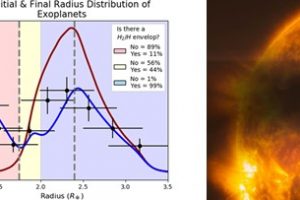Category: Slider
(Italiano) Tre esopianeti (tra cui una super-Terra) per la stella HD 16492
The bimodal distribution of exoplanets radii dictated by ambient UV radiation

To date (2020 March 23rd) there are 4141 confirmed exoplanets in 3072 planetary systems, plus 5075 candidate exoplanets that still await to be confirmed (data from https://exoplanets.nasa.gov/). The number of known exoplanets is large enough to allow astronomers to study their global properties such as mass distribution, orbital parameters, planets dimension and composition, and to put them in relation with the
» Read moreVery hot super-Earths with an hydrogen rich atmosphere. A new model explain how this is possible

“Super-Earths” are rocky exoplanets with a mass between that of Earth and Uranus. Some of these planets may also have a close orbit around the parent star. For instance, the super-Earth 55 Cancri e has a mass of 8.6 Earth masses and it orbits at a distance of 0.016 AU (Astronomical Unit, which is the average distance between Earth and
» Read morePulsations of hot plasma in the magnetic loops in the solar corona

Solar corona is made of plasma at million degrees. The mechanism responsible for the heating of the corona, which is the outer part of the solar atmosphere, is still one of the unsolved problems of solar physics. For comparison, the plasma in the photosphere is on average at about 5600 degrees. It is widely accepted that the responsible for heating
» Read moreThe first exoplanet discovered by TESS around a young star is an inflated planet

The final architecture of a planetary system is the result of a complex interplay between several processes, such as the dispersion of the protoplanetary disk from which the planetary system formed, and the gravitational interaction between the newborn planets. Besides, these processes can be affected by the environment and by their central star. One of the most important process dictating
» Read moreStudy of the thermal structure and UV emission from accreting gas on T Tauri stars from MHD simulations

Pre-Main Sequence stars are young (few million years) stars whose nuclei are not powered yet by the thermonuclear reactions, and that may still accrete gas from a surrounding disk (called protoplanetary or accretion disks). Even if the accretion disks are typically extended more than 100 Astronomical Units (AU, the mean distance between Earth and the Sun, equal to 150 million
» Read moreNew insight on the heating of plasma in coronal loops

The Solar corona is visible in the energetic bands of the electromagnetic spectrum as composed by magnetic arcs filled by plasma at million degrees, which are particularly bright in the active regions. Despite it is clear that the magnetic field plays a fundamental role in heating and confining the plasma, the Solar corona is still a complex region where energetic
» Read moreVariability, rotation and magnetic activity in the pre-main sequence stars in NGC 2264

Pre-Main Sequence stars are young stars whose cores are not dense and hot enough to ignite the thermonuclear reactions that will power them for the rest of their evolution. These stars are sorted in three classes: the youngest stars are the class I sources, still embedded in an accreting envelope of gas; class II stars have dispersed their accreting envelope
» Read moreThe Sun as a star! A unique laboratory to study stellar magnetic activity

Stellar magnetic activity results from the interaction between stellar magnetic field and the plasma in photosphere, chromosphere, and corona. This activity produces well known phenomena, such as flares, spots, faculae, and prominences, observed in stars of almost every type and mass. This activity is typically studied by analyzing spectroscopic activity indicators produced by these phenomena, such as the H and
» Read more

